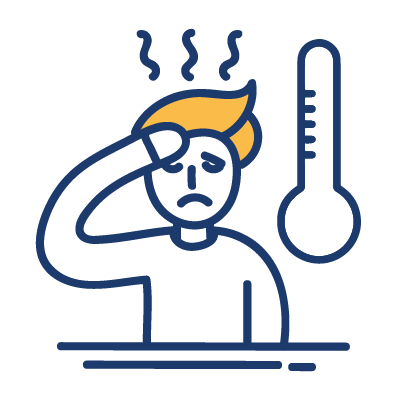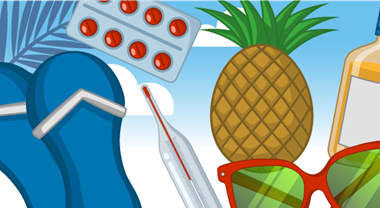Consumer Health

In recent years, patients and consumers have become increasingly aware and active in managing their own health and well-being. A significant finding reported by IQVIA Consumer Health’s Global OTC Insights was that in 2021 the sale of self-medication products grew by 6.7% and that most of these belonged to the personal care category.
This rapid growth is set to continue in the coming years. It is estimated that the global market for solutions for patient engagement in everything related to their care pathway will reach more than USD 22 million by 2027, with a compound annual growth rate of more than 10% between 2020 and 2027 (source MarketWatch).
In this scenario, self-medication, i.e., the use of over-the-counter (also called OTC) drugs that do not require a doctor’s prescription, becomes an important opportunity that can foster greater autonomy and proactivity of patients in managing their lifestyle, health and care.
An increasingly proactive attitude means more attention to prevention, greater awareness of the risks to one’s own health, autonomy in recognising healthier lifestyles, acquisition of tools to detect the early signs of an illness, and fostering contact with one’s doctor.
Angelini Pharma cares for people’s health by putting the needs and wants of patients and consumers at the centre. That is why it works every day with the goal of growing as a market-leading pharmaceutical company, investing in research to carve out a leading role in Consumer Health as well.
In its work, the company has always supported patient empowerment, recognising, spreading and sharing the importance of the therapeutic approach of responsible self-medication, in compliance with the basic criteria of proper medication use.
To do this best, Angelini Pharma is close to people with a highly diversified OTC drug portfolio that includes many new products targeting a wide range of patient groups, such as children, adults, women, and elderly people.
Consumer health key facts
Self-care in Europe
-
 Self-care: beneficial to both
Self-care: beneficial to both
individuals and societies
Positive health outcomes undeniably represent the greatest contribution of self-care. The practice of responsible self-care also results in a more efficient use of resources and a significant reduction in health care expenditure. It plays an important role in improving the competitiveness of European economies by providing incentives for growth in a highly innovative, knowledge-based industry.1
“Self-medication empowers patients to treat or prevent short-term or chronic illnesses which they consider not requiring the consultation of a physician or which may be treated by the people after an initial medical diagnosis”. European Commission Communication on Safe, innovative and accessible medicines.1
Self-care has a number of potential benefits including:- increased access to effective treatment
- reduced number of visits to physicians (thereby alleviating pressure on health care services)
- increased productivity of the population
- increased patient autonomy
- reduced costs to third-party payers, such as government or insurance companies2
The evidence shows that responsible, appropriate self-medication with non-prescription products can provide significant economic benefits for patients, employers, and health care systems worldwide.2
References
- Association of the European Self-Medication Industry. Self-care: a winning solution. Brussels: AESGP; 2012.
- Noone J, Blanchette CM. The value of self-medication: summary of existing evidence. J Med Econ 2018;21(2):201-211.
Headache
-
 The burden of headache in Europe
The burden of headache in Europe

- more than 50% of adults have suffered from headache within the last year
- 60% suffer from tension-type headache
- the prevalence of migraine is 15%
- the prevalence of chronic headache is about 4%
- the prevalence of possible medication overuse headache is 1-2%
- cluster headache has a lifetime prevalence of 0.2-0.3%.5
Most headaches are more prevalent in women, and somewhat less prevalent in children and youth.
Some studies indicate that the prevalence of headache has increased in the last decades in Europe.5 -
 Clinical presentation
Clinical presentation

The third edition of the International Classification of Headache Disorders (ICHD-3) is hierarchical and allows diagnosis in different clinical settings, diagnosing at the first or second level in general practice and at the third, fourth, or fifth level in neurological practice or in headache centres.4
The International Headache Society has two broad categories for headache disorders:- the first is based on symptoms (called primary headache disorders) and includes migraine, tension-type headache and cluster headaches2
- the second is based on their causes (called secondary headache disorders). This includes headaches associated with a head and/or neck injury, stroke, substance misuse and/or their withdrawal (including alcohol), infection, disorders of the cranium, eyes, nose, sinuses or teeth.3
There is a difference between a headache and a migraine headache. Headaches are not usually accompanied by the other symptoms associated with migraine. However, it is quite likely that if you have migraine you will also experience other headaches.2 In general terms, migraine attacks are experienced as a headache of at least moderate severity usually on one side of the head and occurring with other symptoms such as nausea, vomiting, sensitivity to light and noise (although some people experience migraine without headache).2
-
 Social consequences in Europe
Social consequences in Europe

Not only is headache painful, it is also disabling. In the Global Burden of Disease Study, updated in 2013, migraine on its own was found to be the sixth highest cause worldwide of years lost due to disability. Headache disorders collectively were third highest. Repeated headache attacks, and often the constant fear of the next one, damage family life, social life and employment. The long-term effort of coping with a chronic headache disorder may also predispose the individual to other illnesses. For example, anxiety and depression are significantly more common in people with migraine than in healthy individuals.6
Headache disorders are prominent health-related drivers of immense economic losses for the EU.3 This has immediate implications for health care policy. Health care for headache can be both improved and cost saving.7
References
- Association of the European Self-Medication Industry. Self-care: a winning solution. Brussels: AESGP; 2012.
- Headache Classification Committee of the International Headache Society (IHS). The International Classification of Headache Disorders, 3rd edition. Cephalalgia 2018;38(1):1-211.
- Lindea M, Gustavssonc A, Stovner LJ, Steiner TJ, Barré J, Katsarava Z, et al. The cost of headache disorders in Europe: the Eurolight project. Eur J Neurol 2012;19(5):703-711.
- Olesen J. International classification of headache disorders. Lancet Neurol 2018;17(5):396-397.
- Stovner LJ, Andree C. Prevalence of headache in Europe: a review for the Eurolight Project. J Headache Pain 2010;11:289-299.
- The Migraine Trust. Headache. 2019.
- World Health Organization. Headache disorders. 2016.
Female intimate hygiene
-
 Role of female intimate hygiene in vulvovaginal health
Role of female intimate hygiene in vulvovaginal health

The vulva is the first line of defence to protect the genital tract from infections.1
Vulvar skin differs from other skin sites in:- hydration
- friction
- permeability
- visually discernible irritation
- higher susceptibility to topical agents compared to forearm skin because of its increased hydration, occlusion, and frictional properties.1
Supported by international guidelines, daily gentle cleansing of the vulva is an important aspect of feminine hygiene and overall intimate health. Women should be encouraged to choose a carefully formulated and clinically tested external wash that provides targeted antimicrobial and other health benefits without negatively affecting the natural vulvovaginal microbiota.1
-
 Protection from infections
Protection from infections

The normal vaginal flora, acidic vaginal pH, and vaginal discharge are all components of the innate defence mechanisms that protect against vulvovaginal infections. Resident bacteria help maintain an acidic pH and compete with exogenous pathogens to adhere to the vaginal mucosa.1 The importance of vaginal lactic acid needs to be emphasized as it correlates with vaginal health, inhibits the growth of bacteria associated with bacterial vaginosis and possibly plays a role in the local immune defence.1
-
 Vulvovaginal infections
Vulvovaginal infections

Many factors such as:
- immune deficiency
- hormonal changes
- stress
- use of a vaginal douche or soap to clean the vagina
may upset the normal flora and cause infections.1
The vulva is susceptible to dermatitis and other dermatological conditions, particularly when the barrier function of the skin is compromised by factors that constitute the normal vulvar environment, namely, moisture (urine, vaginal discharge), enzymes (stool residue), friction, and heat. 1
Signs and symptoms of vulvovaginal disorders are common (e.g. pruritus, pain and discomfort, changes in skin colour and texture) and can have a significant impact on the quality of life. 1 An extensive review confirmed that molecular vaginal microbiota dominated by Lactobacilli corresponded to a healthy vaginal microenvironment and that bacterial vaginosis should be described as a polybacterial dysbiosis (microbial imbalance) where the Lactobacillus load decreases and the diversity and bacterial load of other anaerobic bacteria increases. Dysbiosis has been consistently associated with increased risk of human immunodeficiency virus (HIV), human papilloma virus (HPV), herpes simplex virus-type 2 (HSV-2), and Trichomonas vaginalis infection.1
References
- Chen Y, Bruning E, Rubino J, Eder SE. Role of female intimate hygiene in vulvovaginal health: global hygiene practices and product usage. Women’s Health 2017;13(3): 58-67.
Upper Respiratory Tract Infections
-
 Main characteristics
Main characteristics

Upper respiratory tract infections (URTIs) are the most common infections in the population. They are the leading cause of people missing work or school and, thus, have important social implications.
The term “upper respiratory tract” covers several mutually connected anatomical structures: nose, paranasal sinuses, middle ear, pharynx, larynx, and the proximal part of trachea.2
Most acute URTIs are caused by viruses, especially rhinovirus, coronavirus, adenovirus, parainfluenza virus, respiratory syncytial virus, and enterovirus. They are responsible for more than 80% of all common colds.2 -
 Common URTI diseases
Common URTI diseases

- rhinitis (inflammation of the nasal mucosa)
- rhinosinusitis or sinusitis (inflammation of the nares and paranasal sinuses)
- nasopharyngitis (rhinopharyngitis or the common cold)
- pharyngitis (inflammation of the pharynx, hypopharynx, uvula, and tonsils)
- epiglottitis (inflammation of the superior portion of the larynx and supraglottic area)
- laryngitis (inflammation of the larynx)
- laryngotracheitis (inflammation of the larynx, trachea, and subglottic area)
- tracheitis (inflammation of the trachea and subglottic area).2
In most cases, these diseases are self-limiting and can be managed at home.2 However, some may cause severe complications.2
-
 Fever and other symptoms of URTIs
Fever and other symptoms of URTIs

Patients with URTIs typically present with:
- runny nose
- sneezing
- congestion
- clear-to-mucopurulent nasal discharge
- an altered sense of smell
- postnasal drip with cough
- low-grade fever2
A fever of moderate-to-high grade suggests a secondary bacterial infection.1
Fever is a normal physiological response to illness that facilitates and accelerates recovery.1 Although fevers are often a presenting symptom of a self-limiting viral infection, they are also associated with serious bacterial infections, such as meningitis and pneumonia, and other non-infective illnesses.1 However, in children, timely identification of those at risk of serious illness allows rapid referral and appropriate management.1 Antipyretics should be used to make the child more comfortable and not used routinely with the sole aim of reducing the temperature.2
References
- Green R, Jeena P, Kotze S, Lewis H, Webb D, Wells M. Management of acute fever in children: guideline for community healthcare providers and pharmacists. S Afr Med J 2013;103(12):948-954.
- Peroš-Golubičić T, Tekavec-Trkanjec J. Upper respiratory tract infections. In: Blasi F, Dimopoulos G, editors. Textbook of respiratory and critical care infections. New Delhi: Jaypee Brothers Medical Publishers; 2015. pp. 16-28.








